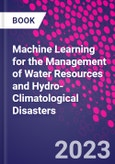Machine Learning for the Management of Water Resources and Hydro-Climatological Disasters provides a comprehensive description and application of ML and DL methods in all major aspects of water resources management and hydro-climatological disasters. Sections cover surface water resources management, groundwater resources management, and hydro-climatological disaster management. Chapters address the major hydro-climatological disasters which pose a threat to communities, include flooding, drought or water scarcity, rainfall induced landslides, snow avalanches, sea level rise and coastal erosion, along with the demarcation of hazard or susceptible zones, inundation zones, assessments of damage, and the management of these disasters.
This book enables researchers and students to gain insights on machine learning (ML) and deep learning (DL) methods and applications. This book should be of great interest to geologists, geomorphologists, hydrologists, geographers, researchers, students as well as disaster management professionals focusing on the management of water resources and hydro-climatological disasters.
Table of Contents
I. Surface water resources management 1. Glacier monitoring 2. Precipitation nowcasting 3. Daily runoff forecasting 4. Stream flow forecasting 5. Identification of marine debris 6. Prediction of harmful algal blooms 7. Prediction of surface water quality 8. Identification of wetlands and the change detection 9. Daily reservoir inflow forecasting 10. Prediction of lake water temperature 11. Change detection of surface water bodies 12. Estimation of snow cover extent and depth 13. Forecasting of water level in lakes 14. Identification of saltwater intrusion
II. Groundwater resources management 15. Groundwater potential zone mapping 16. Identification of groundwater contaminant source 17. Groundwater quality predictions 18. Groundwater level modelling 19. Groundwater vulnerability mapping 20. Identification of artificial groundwater recharge zones
III. Hydro-climatological disaster management 21. Glacier lake outburst flood mapping 22. Flood susceptibility/hazard/risk zone mapping 23. Prediction of flash flood susceptibility 24. Estimation of flood damage 25. Assessment of drought risk or vulnerability 26. Forecasting of drought for dryland region 27. Identifying disaster-related tweets and their spatial and temporal context 28. Prediction of sea level changes 29. Coastal flood modelling 30. Snow avalanche hazard prediction 31. Rainfall induced landslide modelling 32. Mapping of shoreline changes 33. Identification of waterlogged areas 34. Flood inundation mapping








